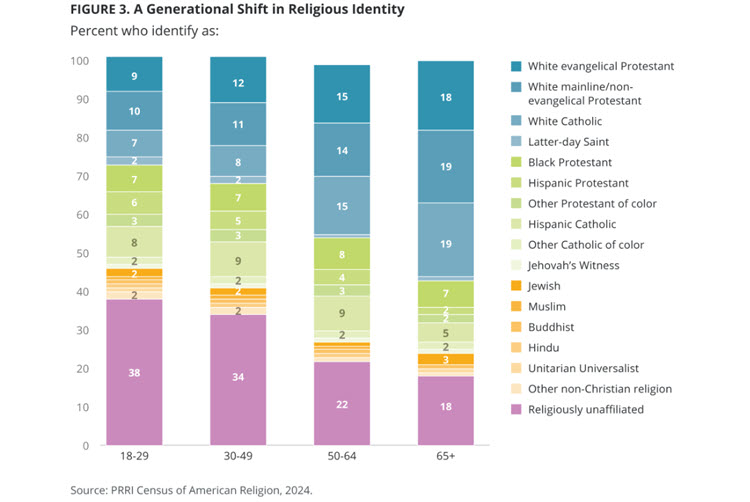The 2024 PRRI Census of American Religion provides an overview of the American religious landscape based on the data PRRI collected from 40,000 survey respondents.
Context
Since launching this blog in 2009, I’ve been calling attention to the decline in traditional metrics surrounding American religious belief, behavior, and belonging.
This survey included many questions, including about religious identity or lack thereof.
Generational Realities
For those familiar with how American religion has been changing and continues to change, it will not be surprising to see that this research supports the general finding of other recent research showing that the oldest Americans have much higher rates of religious affiliation than the youngest adult Americans while the age groups in between fall in between those extremes for non-affiliation.
As a white Mainline Protestant, I write primarily about the group to which I belong. In 2024, the percentage of the population by generational cohort that self-identified as being affiliated with a tradition within white Mainline Protestantism varied considerably by age
- 18-29: 10%
- 30-49: 11%
- 40-64: 14%
- 65+: 19%

Less Religious Over Time
Not only is each generation less religions, each has a smaller percentage who are affiliated with white Mainline Protestantism. The data above showcases this as of 2024. Since this survey has been repeated numerous times, it is possible to compare across time as well.
In 2014 I shared a similar graphic produced by PRRI explaining the generational breakdown using their 2013 survey data. It showed religious non-affiliation rates ranging from 11% for the oldest group (65+) to 31% for the youngest group (18-29 years of age). By 2024 those had risen to 18% and 38% respectively.
Fewer Mainliners
In 2013, the following percentages of respondents were affiliated with white Mainline Protestantism:
- 18-29: 9%
- 30-49: 14%
- 40-64: 15%
- 65+: 23%
This means, the change over the last 11 years by age group is
- 18-29: +1%
- 30-49: -3%
- 40-64: -1%
- 65+: -4%
Only one of four age groups saw an increase in white Mainline Protestant affiliation (18-29) while three groups saw declines in affiliation. The 1% growth in affiliation among the youngest group does not suggest a significant shift is underway. With declines ranging from 1% to 4% for the other three age groups during this 11 year period, Mainline Protestantism declined as a percentage of the American population.
So What?
In 2024, 13% of American adults were affiliated with white Mainline Protestantism, which is down considerably from 16.1% in 2008.
In simpler terms, America has moved from a land where 1 out of every 6.2 people identified as a white Mainline Protestant in 2008 to one in which 1 out of every 7.7 people did in 2024.
How have these trends impact you? your church? your denomination?
Bonus: For a post with links to more than 50 additional posts on Mainline Protestant decline see My Religion is Dying: A Deep Dive into Mainline Decline (June 2024).